Modernizing existing database seems to be the priority for almost all businesses in the current business scenario. Legacy codes become hindrances to the digital transformation of a business, especially its maintenance and scaling potential. That’s where a thorough application modernization roadmap comes in handy. Here’s an insight into this.
Continuous application modernization is critical to running a profitable digital business in a world of rapid technological change. Recognizing the benefits of app modernization is just the first step. It’s equally important to approach app modernization strategically.
When legacy systems don’t align with cutting-edge, cloud-based applications, organizations struggle to achieve flexibility and scalability, often exposing themselves to security risks and unnecessary costs. Additionally, gaining critical business insights from digital data can be difficult or impossible—insights that drive strategy and help companies compete.
Markets and Markets research has projected that the application modernization services will grow to nearly US $ 32.8 billion by 2027.
Wrapping your head around an Application Modernization Roadmap
Application modernization is a multi-staged process designed to move your legacy codebase and applications to a more robust, better infrastructure resting on the latest technology. A haphazard approach to re-architecting or refactoring your IT infrastructure might save resources but produce substandard results.
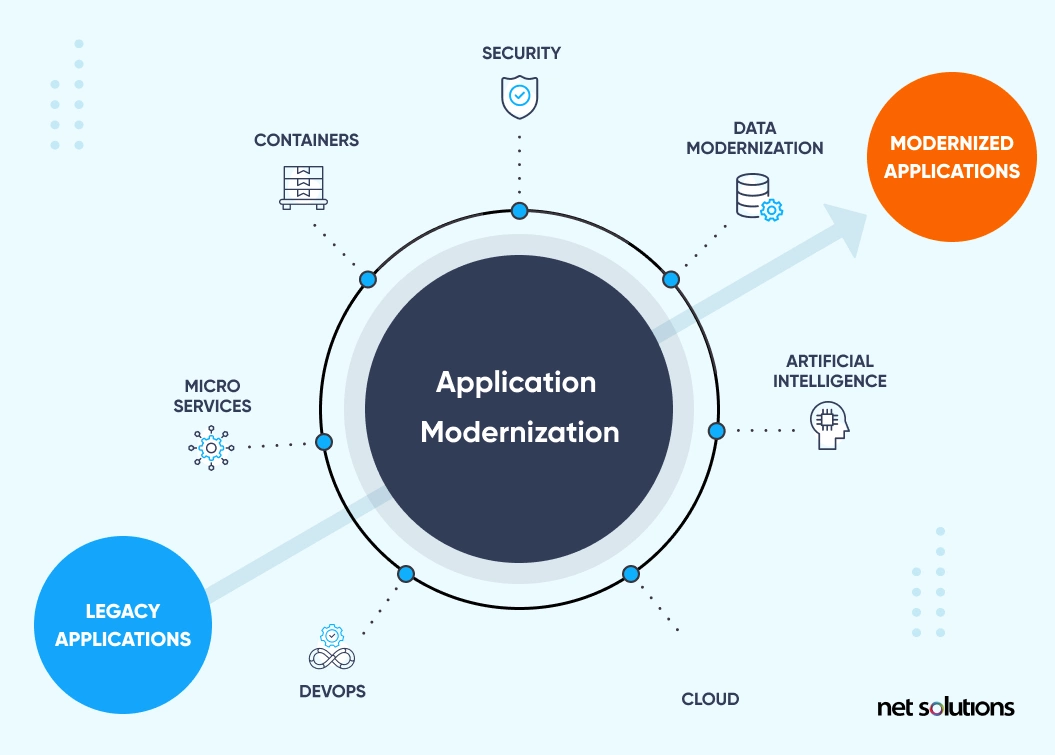
An app modernization roadmap helps you focus on the right things in the most efficient order. An app modernization roadmap is a carefully designed document that outlines the transition to a modern infrastructure. It may range from a single page (for small organizations) to 100+ pages (for large corporations), and it involves intelligent collaboration between IT teams and business stakeholders.
As per Statista, The global application modernization tools market was valued at 8.04 billion U.S. dollars in 2018. The market is expected to grow rapidly in the coming years and reach the size of 36.86 billion U.S. dollars by 2027. The need for digital transformation is driving the demand for application modernization tools.
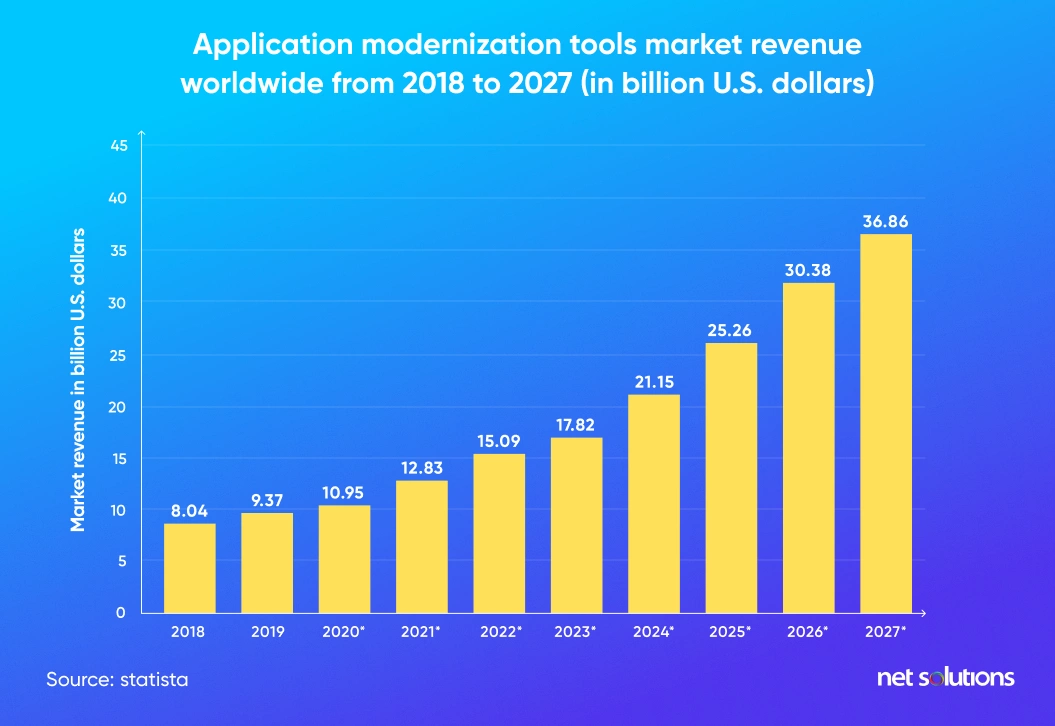
Why you need an Application Modernization Roadmap
Significant business requires a project plan, and app modernization is no different. A roadmap will help establish a clear product vision, identify priorities, and encourage effective communication between departments.
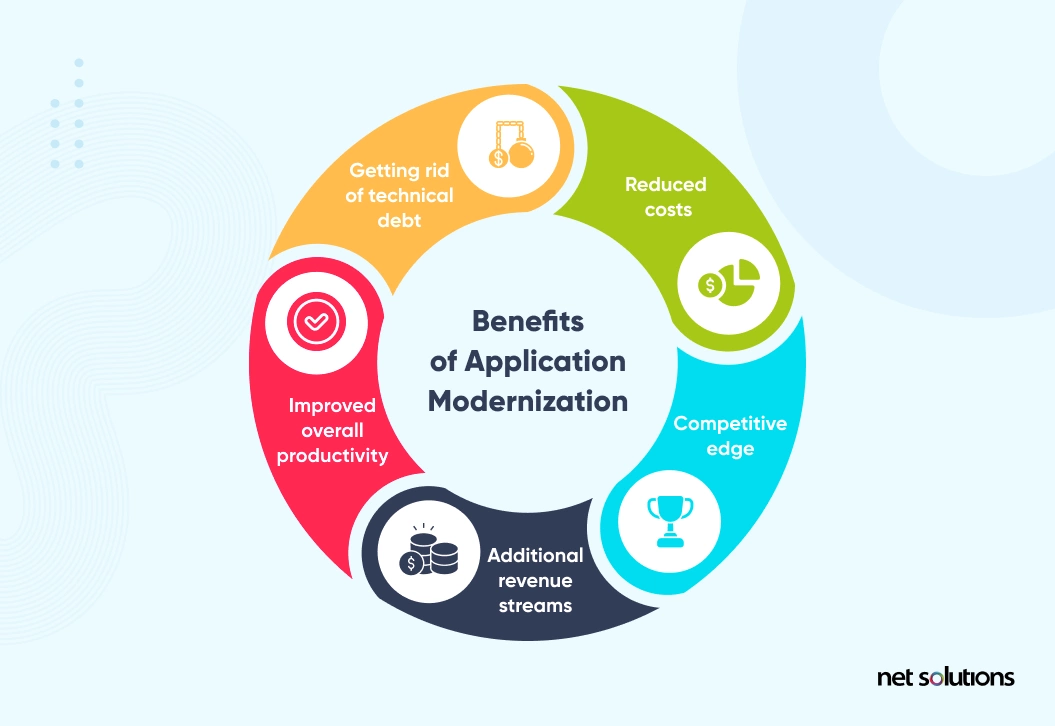
Creating a unified, unambiguous product vision
All digital products should be designed with growth and change in mind. Product teams work tirelessly to improve and outperform the competition based on customer feedback and changing market conditions. Without an app modernization roadmap, it’s challenging to anticipate the underlying infrastructure needs for new changes. A roadmap helps align your product vision with your IT needs to achieve flexibility.Establishing explicit priorities and goals
When updating a complex infrastructure, it’s hard to know where to begin. Some legacy apps are slowing you down more than others. Adding more confusion to the mix, updating apps in a specific order is often necessary since some legacy apps won’t “play nicely” with new technology as it’s introduced. A solid app modernization roadmap identifies the most efficient, effective plan and sets priorities.Encouraging communication between departments
Large organizations are often deeply siloed, and even smaller companies can need help with communication between departments. When it comes to app modernization, effective communication is essential because it affects the organization as a whole. If something isn’t working correctly with your customer relationship management, the Sales Department will be the first to know and often have valuable insights into how the IT team can improve things.
7 steps to creating an Application Modernization Roadmap
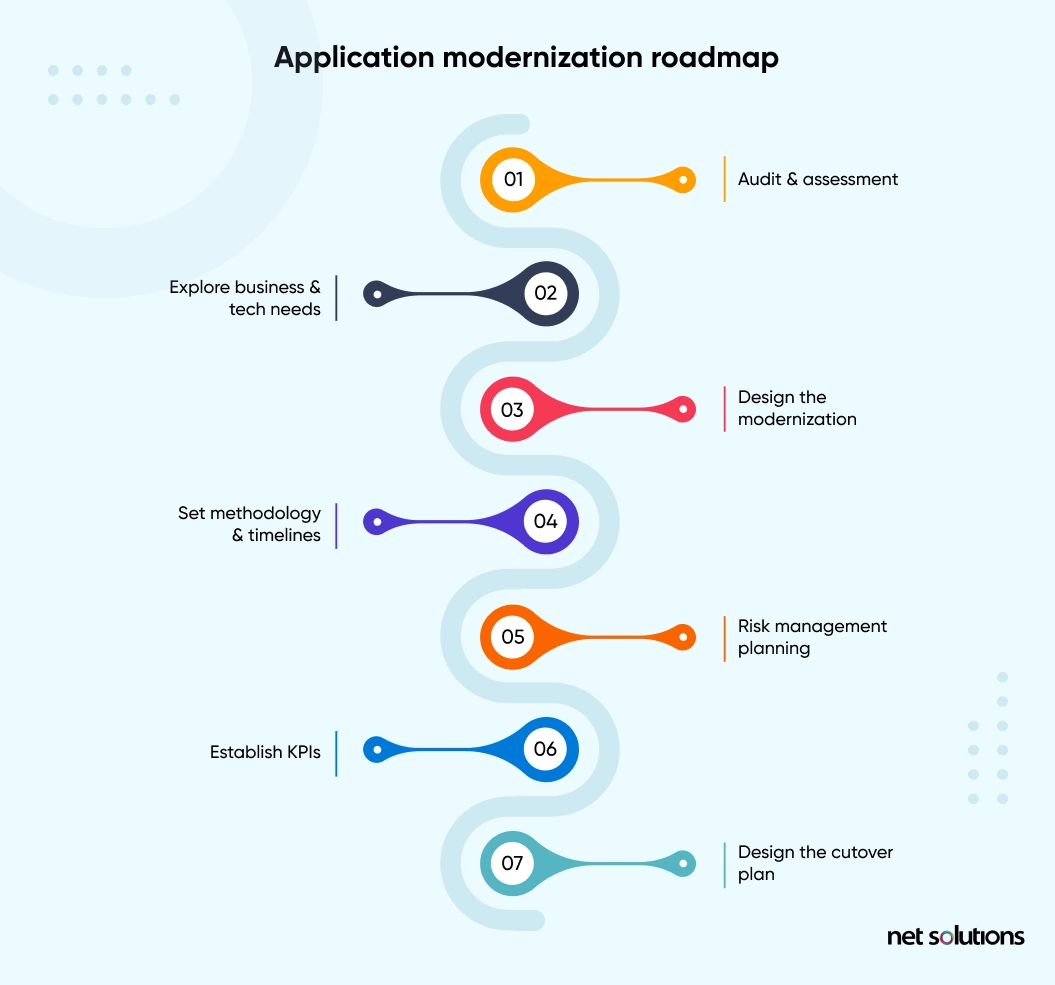
Step 1: Audit your current infrastructure and assess your needs
The very first step in app modernization is to assess your existing IT infrastructure, including all of the following:
- Current hardware and software in use at your organization
- Any integration problems you’re experiencing
- Any existing compatibility issues between apps
- All outdated features that simply aren’t working as expected
Your IT team or a dedicated software development partner like Net Solutions can thoroughly analyze your current architecture and develop a plan forward. However, they can only work with the information they have. Therefore, gathering feedback from different departments regarding the software they use and exploring these issues with all the key stakeholders is essential. With customer-facing IT infrastructure, consult Customer Support teams and explore the Voice of the Customer (VoC) feedback.
In the end, your roadmap document should be able to identify what’s working and what needs to be improved. Without a clear sense of the challenges you face, it’s impossible to prioritize.
Step 2: Explore business and technical needs and capabilities
Now it’s time to analyze your tech needs, so ask yourself the following questions:
- Why is it time to modernize?
- What struggles are end-users experiencing?
- What is the root cause of those struggles?
- Which changes will deliver the most ROI?
Perform interviews with users and key stakeholders, and use tools like the SWOT analysis to analyze Strengths, Weaknesses, Opportunities, and Threats to each modernization projection. Consider all the key elements, such as compatibility with various apps (existing and prospective), current licenses, current costs, potential security challenges, costs for new software implementations, and business priorities.
Step 3: Design your modernization plan
Designing the ideal modernization plan means reviewing your requirements, determining the desired outcome, and deciding how to apply your resources, given your budget and timeframe. The following are some common approaches.
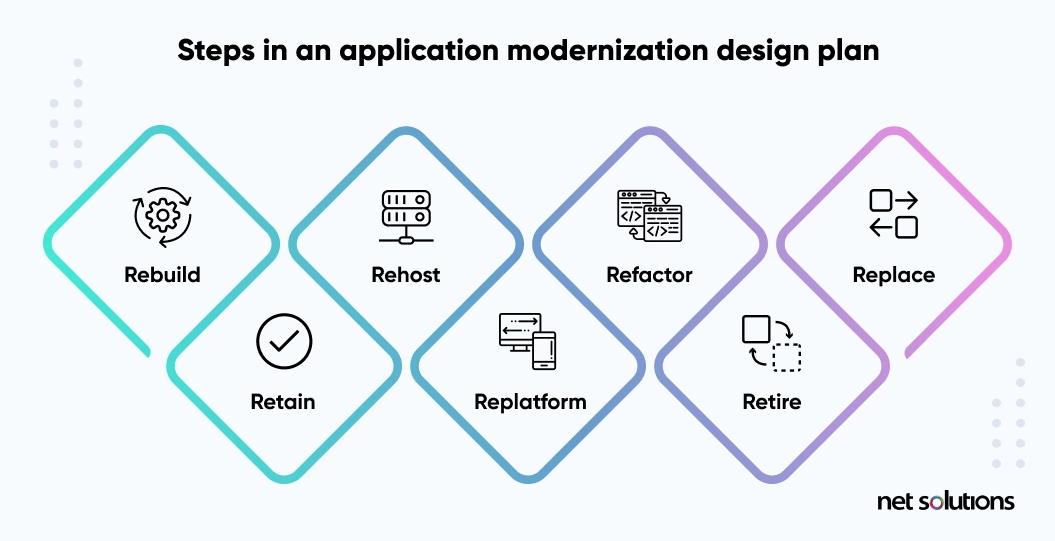
- Refactoring Refactoring involves changing your software system without replacing the underlying code. It results in an improved internal structure, and it often works to solve issues without a complete rebuild.
- Rebuilding Rebuilding means completely replacing all your legacy systems from the ground up. When mapping out a rebuild, clearly explain how every component will work together.
- Replatforming Replatforming means migrating various components of a given application to your new platform, and it typically involves significantly few code changes. It retains the core code, and it’s often ideal for people who don’t want to enact a complete rebuild.
- Encapsulation Encapsulation changes the interface of your legacy system while reusing all of the fundamental components of the infrastructure. It achieves this by building new access layers and removing the legacy code sections. APIs connect the legacy code elements to the new access layers.
Step 4: Set the development methodology + timelines
Selecting a development methodology to guide your app modernization process is essential. Here at Net Solutions, we use Agile for many projects thanks to its flexibility. Whichever methodology you employ, using project management software like Jira to track tasks effectively and keep the software team aligned is vital.
Prioritizing app modernization
App modernization is typically a lengthy endeavor, and it can take time to decide where to begin. Which projects should take priority? One way to figure this out is to use the famous Eisenhower Matrix, which breaks tasks into four quadrants: Urgent & Important, Urgent & Not Important, Not Urgent & Important, and Not Urgent & Not Important. This will help you focus on the most business-critical items.
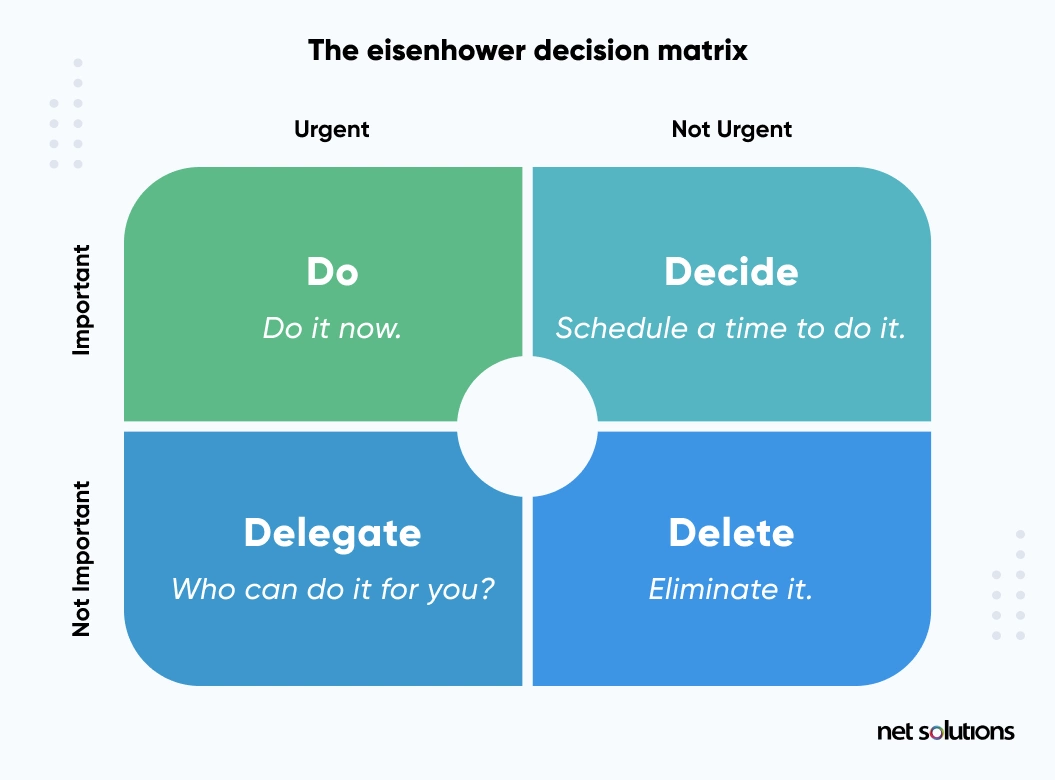
Urgent & Important items are typically tackled first, while Important & Not Urgent tasks can be scheduled for later. You can also create similar quadrants to evaluate the Impact vs. Effort involved in each project and prioritize accordingly. Note that “Effort” includes the time your IT staff will spend on a project and all the financial resources you will put toward it.
Setting timelines
Once you’ve prioritized your projects, create a detailed timeline for your roadmap. Include buffers to account for projects that take longer than expected.
Step 5: Write your risk management plan
Risk is inherent to any software project, and application modernization is no exception. Any time you alter the foundational elements of your IT infrastructure, you run the risk of downtime, data loss, reputational damage if you struggle to serve customers, security breaches, and losses in productivity. In contrast, employees and customers adapt to changes.
Of course, the risk of refusing to modernize would be catastrophic in the long run since no business can truly thrive on legacy systems over the long haul. With this in mind, your app modernization roadmap should identify possible risks and include a plan for mitigating them to the best of your ability. For example, suppose your migration might result in downtime. In that case, you’ll want to create a backup plan to enable users to access their data and any applications essential to performing their jobs.
Step 6: Establish Key Performance Indicators (KPIs) to measure success
How will you measure your success when it comes to app modernization? As with many other business strategies, it’s best to establish clear Key Performance Indicators (KPIs) that will tell you whether you’ve achieved your goals. KPIs should address speed, uptime vs. downtime, security, and cost-efficiency. It may also address customer satisfaction (CSAT) and other customer success metrics related to specific features within customer-facing apps.
Step 7: Carefully design your cutover plan
What is a cutover? During any migration, there you’ll have those critical periods of transition where the new system replaces the old one. This is known as the cutover period, and to avoid significant hassles, losses in productivity, and angry customers, you need an intelligently designed cutover plan.
Your cutover plan should specify all the tasks you must complete before changing. Ensure all the stakeholders receive a copy of the cutover checklist and ensure everyone understands why each item is essential. Also, be sure everyone understands that only select team members are allowed to do anything that affects the production environment during the cutover.
Key elements of an effective Application Modernization Roadmap
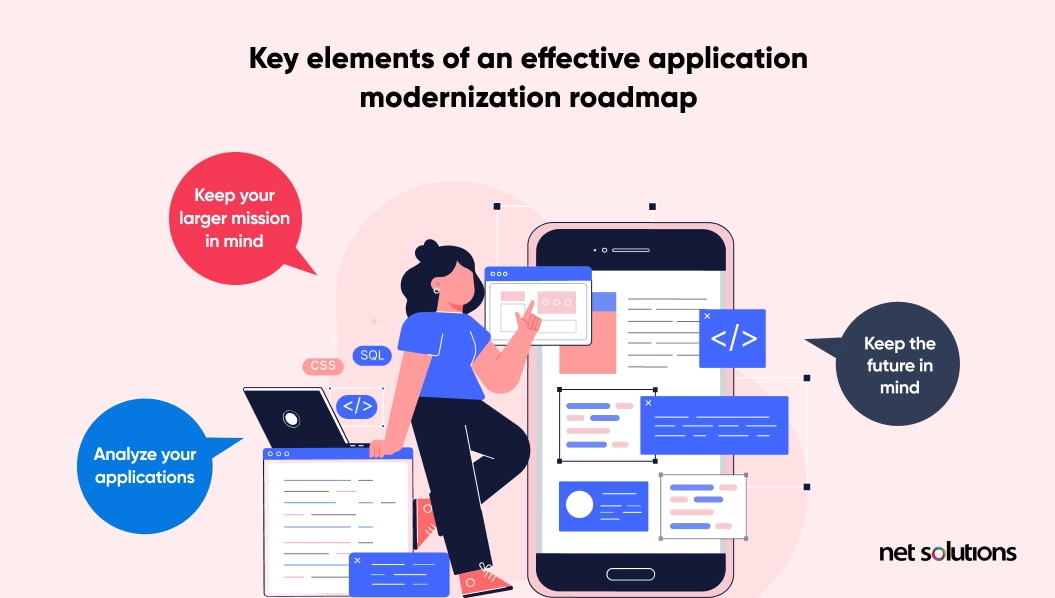
When creating an app modernization roadmap, it’s essential to remember the big picture. Address the following four principles in your roadmap to avoid getting lost in the weeds and failing to deliver on your larger objectives.
- Keep your larger mission in mind What does your organization do to improve the lives of its customers? How does it bring value that your competitors don’t provide? When developing an effective app modernization roadmap, prioritizing tasks, and assigning resources to each project, think long and hard about how it fits into your organization’s mission.
- Analyze the current state of your applications before you begin Unless you have a clear picture of where you are, you can never plot a course for the promised land you’re hoping to reach. Your app modernization roadmap must take an unflinching look at all your current limitations and how they impact your company. Only then can you chart a path forward and address your most pressing issues first.
- Keep the future in mind App modernization isn’t just a one-time thing. Technology is constantly improving, and as new apps become part of your business’s IT infrastructure, you must reassess your situation. Approach app modernization with flexibility and future-proofing. When implementing a new piece of software, ensure the new app will integrate seamlessly with anticipated updates to your general infrastructure.
Collaboration and future updates
We’ve said it before, and we’ll repeat it, app modernization is a collaborative process. It requires input from stakeholders from different departments to ensure that voices are heard from across the organization.
Once you’ve developed your roadmap, gained feedback from key stakeholders, and begun implementing changes, you’ll likely discover new opportunities and risks. Latest technology will enter the picture, market forces will favor certain features over others, and you will need to adjust your roadmap accordingly.
Just as software methodologies like Agile are designed to be flexible and adapt to these changes, strategic app modernization should be flexible over the long haul. That’s why it’s vital to continuously gather user input, assess your efforts, and keep the larger vision in mind. If you treat your roadmap as a living, breathing document, you can periodically refine your app modernization strategy to deliver on your company’s central mission.
Is it time to modernize IT infrastructure?
Net Solutions’ skilled team of analysts, project managers, designers, developers, and QA specialists can help you achieve a modern, flexible, scalable IT infrastructure.
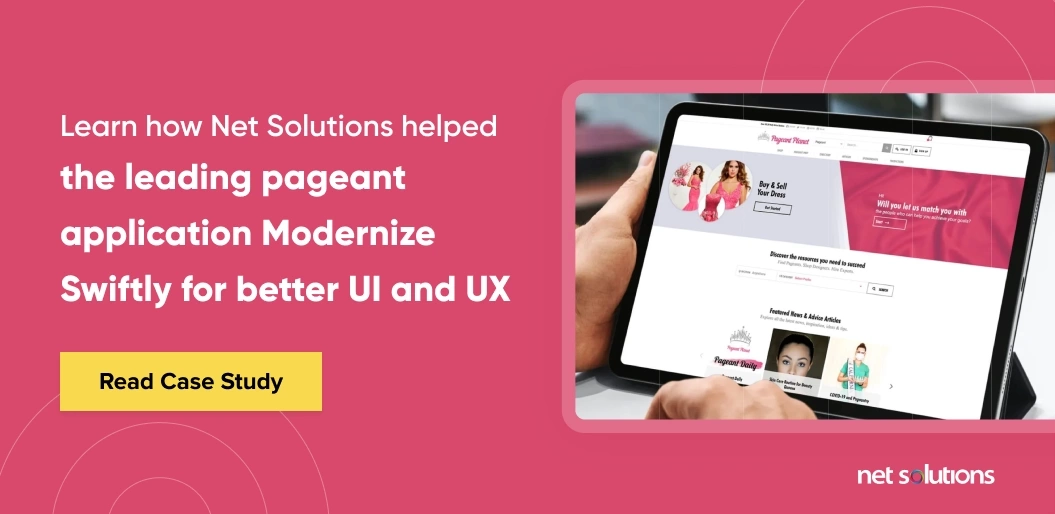
Frequently Asked Questions
1. What services fall under application modernization?
Application modernization services include in-depth analysis of current systems, comprehensive app modernization strategizing, design, development, and QA testing—all services we provide at Net Solutions.
2. What is the difference between app modernization and development?
Software development involves designing and building specific software products. App modernization takes a strategic approach to create a modern IT infrastructure that supports an organization, its operations, and its customers’ needs. This can include modernizing apps that support digital, customer-targeted products and internal business operations, such as Enterprise Resource Planning (ERP) software and Client Relationship Management (CRM) platforms.
3. What would be the most crucial factor in starting the modernizing process for an application?
The most significant factor in deciding to start an application modernization process is assessing the application. When creating a transformation, the first step should be to take stock of your applications. Listing these apps in terms of the difficulties or ease of functioning and the potential increase in value post-modernization.
4. What could be three transformations that power an application modernization process?
Three significant transformations could empower application modernization for most businesses – Infrastructure, DevSecOps, and Microservices & Application patterns. There must be a data center transformation, followed by a shift in operating models. The last bit is the applications themselves. Frequent changes, the best security practices, and innovative data uses must follow modern application patterns such as microservices architecture and API-first design.
SHARE THIS POST
Table of Contents
Related Services
Related Resources
- A Framework-based Approach for App Assessment
- App Modernization Benefits To Boost Your ROI and Future-Proof Your Business
- 11 Top Application Modernization Best Practices in 2024
- Building a Winning Application Modernization Business Case
- Legacy Application Modernization Case Studies & Success Stories
- Solving the Toughest Application Modernization Challenges
- Cloud-Native Application Modernization: Benefits & Strategies
- 8 Core Application Modernization Drivers
- Enterprise Application Modernization: Complete Guide [2024]
- Lift and Shift: The Modernization Formula for Legacy Apps
- Navigating Application Migration and Modernization [Guide]
- Application Modernization and Optimization: A Complete Guide
- A Practical Approach to Application Rationalization: A CIO's Guide to Managing Complexity and Reducing Costs
- What is Replatforming? A Beginner's Guide to Upgrading Your Technology Stack
- Application Modernization Services Market: Comprehensive Analysis
- A Step by Step Guide to Application Modernization Strategy
- Explore the Best Application Modernization Tools and Resources
- 13 App Modernization Trends That Can Support and Optimize Your App Modernization Strategy



